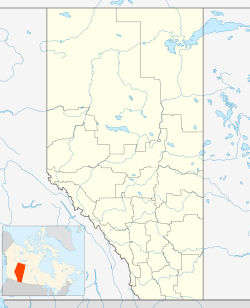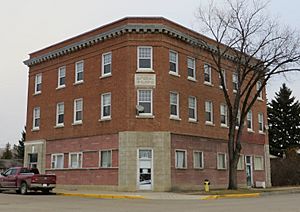Vermilion, Alberta facts for kids
Quick facts for kids
Vermilion
|
|
|---|---|
|
Town
|
|
| Town of Vermilion | |
| Country | Canada |
| Province | Alberta |
| Region | Central Alberta |
| Census division | 10 |
| Municipal district | County of Vermilion River |
| Founded | 1902 |
| Incorporated | 1906 |
| Area
(2021)
|
|
| • Land | 12.72 km2 (4.91 sq mi) |
| Elevation | 580 m (1,900 ft) |
| Population
(2021)
|
|
| • Total | 3,948 |
| • Density | 310.4/km2 (804/sq mi) |
| Time zone | UTC−7 (MST) |
| • Summer (DST) | UTC−6 (MDT) |
| Forward sortation area |
T9X
|
| Area code(s) | +1-780 |
| Highways | Highway 16 Highway 41 |
| Waterway | Vermilion River |
Vermilion is a town in central Alberta, Canada. It is surrounded by the County of Vermilion River. The town is located where Highway 16 (also known as the Yellowhead Highway) and Highway 41 (the Buffalo Trail) meet. Vermilion is about 60 kilometers (37 miles) west of Lloydminster. It is also about 192 kilometers (119 miles) east of Edmonton.
History of Vermilion
Early Settlers and Growth
Many settlers arrived in the Vermilion area in 1902. Most of these new residents came from the east and had a British background. Just west of Vermilion, the settlers were mainly of Ukrainian background. They had traveled from the west.
In 1904, a post office was set up in a place called Breage. This was about 5 kilometers (3 miles) east of where Vermilion is today.
The Arrival of the Railway
The Canadian Northern Railway reached Vermilion in 1905. A train station was built, and the post office moved from Breage to the new townsite. The railway was very important to Vermilion when steam trains were used.
Vermilion became a major stop for trains. It had a water tower to refill engines and a large roundhouse. There was also a big train yard, a wye, and a turntable. Train crews could rest at a bunkhouse. The railway became less important after the 1950s when steam power was no longer used.
Becoming a Town
Vermilion was officially made a village in early 1906. Later that same year, it became a town. The name Vermilion comes from the red clay found in the river valley nearby.
One of the first businesses in Vermilion was a brick factory. It made bricks from 1906 to 1914. Some buildings in Vermilion today are still made from bricks from this factory.
Local Newspapers
The first newspaper in the Vermilion area was the Vermilion Signal. It was started and edited by William Bleasdell Cameron. He was a survivor of the Frog Lake Massacre. In 1909, S.R.P. Cooper started the Vermilion Standard. This newspaper is still published today.
Agricultural College
In 1911, the government started three special farms to show new farming methods. One of these was near Vermilion. The Vermilion Board of Trade had asked the government for a farm or college.
The Vermilion School of Agriculture opened on November 17, 1913. It was the first agricultural college in the province to open. Over the years, its name changed several times. In 1975, it became Lakeland College.
Big Fire and Old Businesses
Like many towns on the prairies, Vermilion had a large fire. On April 10, 1918, the fire destroyed 28 stores and business buildings.
Two businesses in Vermilion have been open since before the town was officially formed. Craig's, a department store, and Long's, a drugstore, have been in the same downtown spots since 1905.
Vermilion Today
Population and People
In 2021, the Town of Vermilion had a population of 3,948 people. These people lived in 1,678 homes. The town covers an area of 12.72 square kilometers (4.91 square miles). This means there were about 310 people per square kilometer.
Town Leadership
The Mayor of Vermilion is currently vacant. The town is governed by the Vermilion Town Council.
Economy and Jobs
Vermilion's economy mostly depends on services for agriculture. This means many jobs support farming in the area. Education is also a big part of the economy, thanks to Lakeland College.
Arts and Culture Events
The Vermilion Agricultural Society holds an annual fair. This fair started in 1906. It begins with a parade on Thursday morning and lasts for three days. The fair usually takes place on the last weekend of July.
Fun Attractions
Vermilion Provincial Park is located on the northwest side of town. It is a great place for outdoor activities. You can go camping, fishing, or canoeing there. The park also has trails for hiking, cycling, and cross-country skiing in winter.
Education Opportunities
Vermilion has several schools for students. There are two public schools: Vermilion Elementary (for Kindergarten to Grade 6) and J.R. Robson Secondary (for Grades 7 to 12). There is also one Catholic school, St. Jerome's School (for Kindergarten to Grade 12). The School of Hope, which helps students learn at home, has its main office in Vermilion.
Many students from all over Canada come to Lakeland College in Vermilion. The college offers many different programs. These include programs in agricultural sciences, business, and environmental sciences. They also have programs for fire and emergency response, interior design, and various trades. More than 500 students live in the college's residence village.
Local Media
Vermilion has two local weekly newspapers. They are the Vermilion Standard and the Vermilion and Area Voice.
Famous People from Vermilion
- Brandon Baddock (born 1995), a professional ice hockey player.
- Bill Flett (1943–1999), a former NHL player.
- Ernie Isley (born 1937), a politician in the Legislative Assembly of Alberta.
- Alison Jackson (born 1988), an Olympic racing cyclist.
- Ron Jones (born 1951), a former NHL player.
- Ernie Kenny (1907–1970), a former NHL player.
- Susan Massitti (born 1962 or 1963), a Winter Olympic speed skater.
- Brent MacNab (1931–2020), a former professional ice hockey player.
- Grant McNeill (born 1983), a former NHL player.
- Charlie Mead (1921–2014), a former MLB player.
- Jean Paré (1927 - 2022), author of Company's Coming cookbooks.
- Beckie Scott (born 1974), a Winter Olympic cross-country skier and gold medalist.
- Lloyd Snelgrove (born 1956), a politician in the Legislative Assembly of Alberta.
- Jeff Woywitka (born 1983), a former NHL player.




